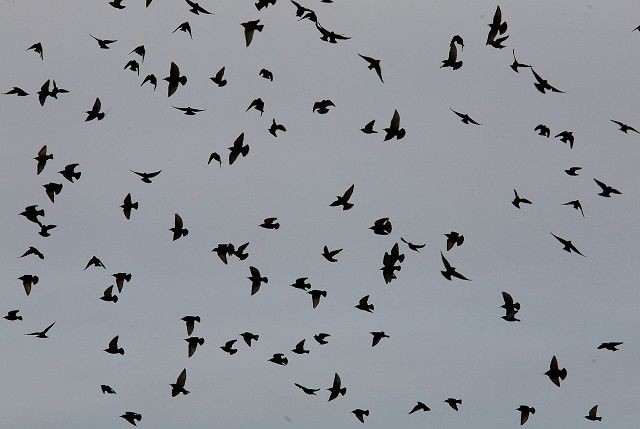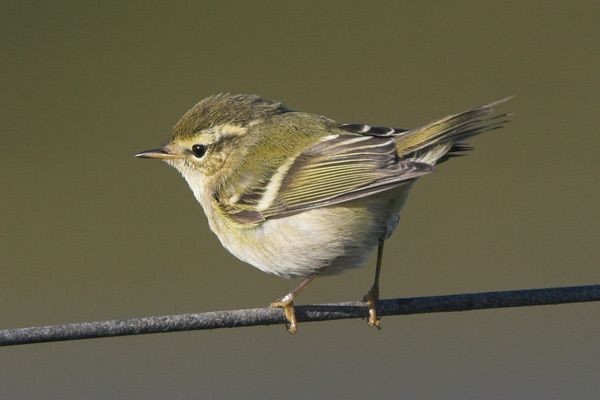
Starling (Photo: Jack Hill)
As all good birding augurs know, during these short winter days it is the weather that mostly dictates proceedings. Settled mild weather, as has been a feature of many a recent December, conveys a staleness to the roll-call on Bird News Extra with just the odd new bird to vary the daily reports. By contrast, a sharp cold snap extending across northwest Europe can suddenly provide an infusion of action to focus the enthusiasm of the patchwatcher and self-finder as a rapid immigration of birds takes place.
Many of our winter visitors should have arrived by now, though a mild start to the winter, such as this year, might mean that many have delayed their crossing of the North Sea. In recent times hard-weather movements have been in short supply and are unlikely until the end of the month if they're going to happen at all, especially as the time when 'winters were winters' appears long gone and most Decembers tend to be tame affairs wrapped up in a milder airflow off the Atlantic.
It is easy to be lulled into inactivity during December. There is generally little of the excitement of the preceding months, and the combination of very short days and the focus on Christmas makes it easy to find alternative ways of occupying your time as motivation gives way to competing distractions. For year-listers though the 31 days offer them a last opportunity to fill any obvious gaps on their lists that remain unfilled from earlier in the year.
Understandably, much of the focus is centred upon wildfowl and gulls, with many birders opting to watch their local wetlands or estuaries, in the hope of detecting something more unusual. Shun the month at your peril though for over the years December has delivered its fair share of quality rarities.

Baltimore Oriole (Photo: Paul & Andrea Kelly)
So, what of these December rarities of recent times? Despite the recent glut of American Buff-bellied Pipits it was one in Lincolnshire in 2005 that broke the mould for mainland birders, and who would bet against another being found at an equally accessible location in the coming weeks as part of the present influx? In 2002 it was an inland Blyth's Pipit in Nottinghamshire that came as an unexpected surprise and in 2003 a superb Baltimore Oriole in Oxfordshire delighted the masses. There was also the inland Sora in Nottinghamshire in 2004. All of these were testament, if needed, to the 'anything is possible anywhere' hypothesis! Those with much, much, longer memories will recall that the Cleveland Dusky Thrush of 1959 was first found in December though it lingered through to February. A present-day repeat performance would be an enticingly popular attraction. Obviously a good month for the symbolic Robin, December is also, statistically at least, the best month in which to find an American Robin - keep those bird tables well stocked!

Buff-bellied Pipit (Photo: Steve Morgan)
Other rarities with a penchant, numerically, for making an appearance during the festive period include the eye-catching Little Bustard, of which the month has yielded the most appearances: an influx of four in 1987 included one in Dorset and then Hampshire which led many a merry song and dance. Likewise December is one of the two best months for occurrences for the species' larger counterpart, the Great Bustard. The last wild individuals of this huge bustard arrived during a mid-winter influx in 1987; sadly, with birds from the reintroduction scheme wandering widely nowadays, any finder of this statuesque species would muffle their excitement at such a find. Amongst the waders many species are possible, though some are more closely associated with the winter months than others. December finds of Killdeers are only just outnumbered by January ones and many observers at this time of year busy themselves with scanning Northern Lapwing flocks in the hope of finding an enigmatic Sociable Lapwing, though midwinter does not offer the best prospects for such a find.

Killdeer (Photo: Steve Morgan)
For duck-watchers there are endless options, from your local gravel pit to the coastal bays. Formerly mega-rare ducks nowadays seem to have little difficulty in easing their way into the national statistics and site-fidelity ensures that many return in subsequent years, Barrow's Goldeneye one such species that has proved accessible in recent years. Amongst your local diving ducks look for Ring-necked Ducks or the increasingly regular Lesser Scaup. At the coast rafts of scoter can be scanned for Surf Scoters or for the keen-eyed the accolade of the first White-winged Scoter for Britain or Ireland awaits. Amongst the dabbling ducks Falcated Duck and Baikal Teal are eagerly sought, both probably less tainted by the escape tag in recent times given that vagrancy to Europe has been proven, though American Wigeon or Green-winged Teal are much more realistic scarcity prospects. A long-shot option involves the less enticing prospect of scrutinising your local Coot flocks for American Coot - some must be overlooked?

Green-winged Teal (Photo: Steve Round)
It's a good time of year to be out and about grilling geese flocks. Head to Islay to confront the challenge of picking out the bewildering array of vagrant Canada Geese arriving on our shores each winter, whilst Red-breasted Geese appear to be fair game as genuine vagrants when either Barnacle Geese or Brent Geese are there for company. Taiga Bean Geese can be relied upon in Norfolk and Central Scotland, whilst small numbers of Tundra Bean Geese can be expected in most years, though finders must beware the usual Pink-footed Goose pitfall.

Ivory Gull (Photo: Fraser Simpson)
Gull-watchers maintain the momentum gathered in November, with many of the scarcer species an option at inland roosts or coastal bays; this family does allow observers anywhere the opportunity to stumble across something more unusual. Ivory Gulls are keenly anticipated by watchers in northern settings: after all December, along with January, accounts for an overwhelming proportion of the national records for this deservedly popular gull. White-wingers start to increase in number, being more prominent at your local harbour, tip or roost, though numbers are below their peak. Also on the radar for watchers of large gull congregations are Caspian Gulls, especially smart first-winters which are at their most obvious at this time of year. It is a normally a quiet month for seawatchers, but anything is possible at this time: take for example the exceptional numbers of Leach's Storm-petrels last year, and the continuing presence of Little Auks may well linger into December this year, though their movements become less predictable.

Yellow-browed Warbler (Photo: Michael McKee)
You don't have to peer through endless expanses of water to derive some form of interest from the month. Milder winters have provided increasing numbers of wintering Yellow-browed Warblers, whilst sifting through tit flocks could always unearth a jewel in the shape of a dazzling Firecrest. Rough inland fields may just hold a Richard's Pipit and wintering Dusky Warblers are becoming increasingly regular. Finch flocks, if you can find them, are worthy of scrutiny, and Siskin and Lesser Redpoll flocks invite sifting through for a Mealy Redpoll, or perhaps even an Arctic Redpoll. Tit flocks also merit a second glance just in case they're carrying a Lesser Spotted Woodpecker, and those of you for whom Hawfinch is a bogey bird should pay heed to the Bird News Extra page, or head to traditional haunts, to seek out your prey.

Bittern (Photo: Brian Irvine)
During any cold spells that occur a visit to your local reedbed is worthwhile on the off-chance of a Bittern forced out of its reedy hideaway. At larger reedbeds, enjoying a harrier roost can be an exciting way to see out the last hour of the short day, especially if a ghostly male Hen Harrier comes into view. Owl roosts can be quite obvious at this time of year, with communal roosts of Long-eared or Short-eared Owls, though remember: if you do visit these, ensure that you view from a distance and be careful to avoid any disturbance as such roosts are exceptionally vulnerable. For a true avian spectacle, venture no further than your local Starling roost, or visit one of the popular huge roosts present around the country.

Long-eared Owl (Photo: Lee Fuller)

